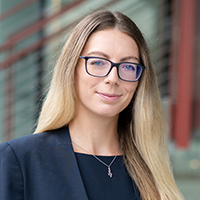
NLD Event Recap: Federal Court Practice Series

Partner at Pengilley Myers APC
On February 15, 2023, the New Lawyer Division was honored to be joined by Chief Judge Dana M. Sabraw of the U.S. District Court for the Southern District of California for the first of its biannual court practice series programming. Judge Sabraw was nominated by George W. Bush to the federal bench on May 1, 2003, and then unanimously confirmed by the Senate. He became chief judge on January 22, 2021. Judge Sabraw provided insightful tips and guidance on best practices in federal court, including his thoughts on Complaints, FRCP 12(b)(6) motions (motions to dismiss), FRCP 56 (c) motions (motions for summary judgement), briefings, oral arguments, and advice on obtaining judicial clerkships.
Judge Sabraw noted when it comes to 12(b)(6) motions, one mistake attorneys make is overestimating the importance of “whether [the motion] should be brought in the first place.” It’s a narrow standard, and one can always file a motion on the pleadings. When an attorney does file a 12(b)(6) motion, Judge Sabraw emphasized the importance of meet-and-confer efforts, and that the best way is in-person, via zoom, or by phone. He stated the “worst way is by email.”
When it came to tips regarding preparing briefs, such as motions for summary judgement, Judge Sabraw stated that the introduction “should win the reader over.” He advised that lawyers keep introductions to one to two paragraphs and include the following information: here’s what we want, here’s why we win, and a brief synthesis of your case. “Brevity is the soul of wit,” Judge Sabraw espoused, quoting Shakespeare. He advised lawyers to “state it succinctly.” In practice, judges are grateful when they have short, succinct briefs to review. Some of the best briefs he has reviewed have been short.
Generally, in federal court there is no right to oral arguments. However, when oral arguments are permitted Judge Sabraw advised that lawyers always stand up at the podium to make their arguments rather than stay seated. But if there is going to be a back-and-forth discussion with the judge and opposing counsel, you may ask the judge for permission to sit down and do your argument from counsel’s table.
For those interested in judicial clerkships, Judge Sabraw noted good grades and law review are key, and that many law clerks have practiced for three to five years before applying to do a clerkship.
The program ended with a Q&A, and Judge Sabraw encouraged those in attendance and new lawyers in general to observe jury trials, as well as observe sentencing hearings, which are held in his court room every Friday.
The CLE event was held at the SDCBA 11th floor Bayview conference room and was followed by an intimate meet-and-greet with Judge Sabraw himself, where members could ask him one-on-one questions regarding career advice and for tips regarding their own practice. For those who could not attend in-person, the event was also held via Zoom.
This CLE program was specifically unique in that it was the first time NLD held a personal meet-and-greet with the judge after the CLE programing itself. Even without a formal meet-and-greet judges are always willing to meet with law students and new lawyers, so I encourage anyone who can attend the court practice series in-person to do so, because they are truly a once in a lifetime opportunity to learn from judges.
NLD’s court practice series goals are to provide new lawyers with invaluable and successful tips directly from the courtroom itself. Judge Sabraw’s insight did not fail to reach such goals. Judge Sabraw’s invaluable tips and guidance on how to practice in federal court will be something I utilize throughout my career.